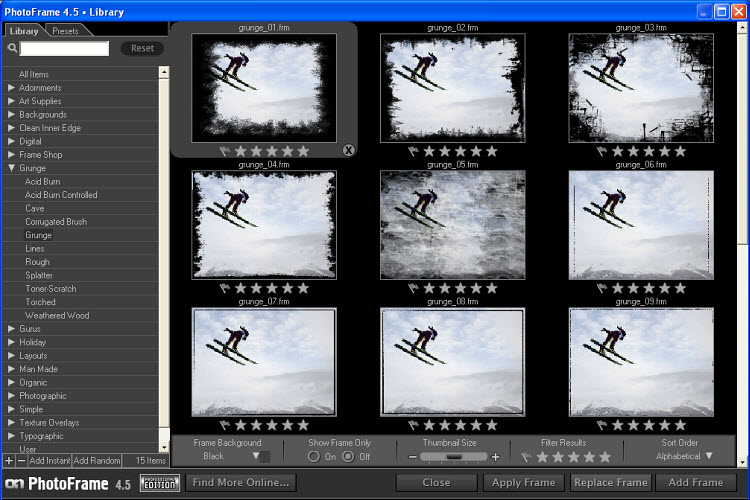The last step in PhotoFinishing is to add a frame to your image – and this can be an extraordinarily dangerous business. I have seen too many very good shots diminished by overstated metal/wooden frames and mattes. And in the digital world , the ability to do great harm to a good image seems to be enhanced with sophisticated photo finishing programs with layering like Corel Painter or Paintshop Pro and especially Adobe Photoshop.
That is why I like the crop of new plugins like onOne’s PhotoFrame 4.5 – $260US and Auto FX’s Photo Graphic Edges – $250US.They allow you to do two things very quickly: 1)tryout a very broad range of frames and edges[literally hundreds in all sorts of styles] very quickly and 2)customize the fit, width, coloring and opacity of those digital frames – again very quickly. True you can do it yourself in Painter or Photoshop using layers and brushes and sophisticated resizings/actions. But that is the problem – one becomes so invested in getting that grunge frame looking exactly right – one is not willing to walk away from it when it deflates the image it is supposed to enhance. So perhaps the biggest advantage is that Frame/Edge plugins allow a photofinisher an opportunity to see quickly how a framing will work [- or not] for a particular image.
Examples of Frames
Enter onOne’s PhotoFrame 4.5 for example.

onOne Photoframe Design Interface
One can quickly see how good [or bad] a frame will look on your image. Err on the sides of simplicity and expression. The frame should not be ostentatious and drawing attention away from the main image. It also shoul help to express the feeling you want to convey with the image. Here are some examples.
Using onOne’s PhotoFrame
Frames allow photo finishers to direct attention and add an emotional suggestion or hint to a photo. The first example of the Chinese gold medal figure skating pairs in practice, uses a line frame [the image on the right] to hint at the tentative nature of the practice skate with incomplete thin lines around:

Frame emphasizes tentative nature of practice
In contrast the second image uses a bold frame for ski-jumping. The Whistler area has such beautiful panoramas and the ski-jumping event for most observers is like being launched into a new new world . This is the reasoning behind the use of the special artists frame:

Frame accentuates soaring into anew world view
autoFX Photo Graphic Edges examples
I really like the design interface for PGE-PhotoGraphic Edges. Its easy to navigates and gives users control over a lot of the frame/edge settings such as border, color, width of border etc. Here we use a grunge Edge to suggest that the downhill racers could easily go splat with a high speed tumble:

And here is an example of the before and after splat look:

Unfortunately our subsequent experience with autoFx PGE plugin was quite erratic. On the same Windows XP 2.0GHz 3GB RAM machine that PhotoFrame 4.5 performed flawlessly on, PGE produced quite a number of crashes like this:

PGE Designer Crashes Many Times
This is too bad because the filters and edges in PGE are very promising and the design interface very approachable.
Summary
Adding frames to your photo can be done either in software primarily as outlined here or using the glass, matte and framing crafts of Frame Store. i have always had troubles with the glass, even acid treated glass on photo images, so I tend to favor the software approach. But – as seen here, make sure the frame works for you image – working to convey the over all impression intended.
